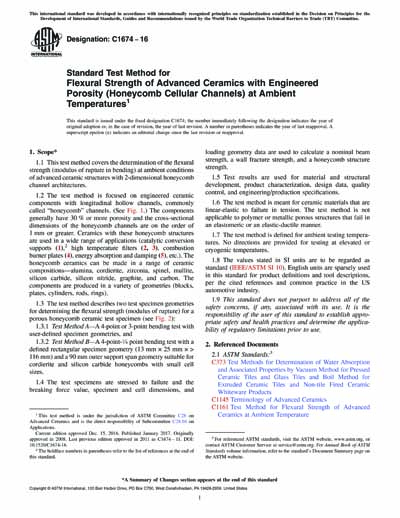Historical
ASTM C1674-16
Standard Test Method for Flexural Strength of Advanced Ceramics with Engineered Porosity (Honeycomb Cellular Channels) at Ambient Temperatures
1.1 This test method covers the determination of the flexural strength (modulus of rupture in bending) at ambient conditions of advanced ceramic structures with 2-dimensional honeycomb channel architectures.
1.2 The test method is focused on engineered ceramic components with longitudinal hollow channels, commonly called “honeycomb” channels. (See Fig. 1.) The components generally have 30 % or more porosity and the cross-sectional dimensions of the honeycomb channels are on the order of 1 mm or greater. Ceramics with these honeycomb structures are used in a wide range of applications (catalytic conversion supports (1),2 high temperature filters (2, 3), combustion burner plates (4), energy absorption and damping (5), etc.). The honeycomb ceramics can be made in a range of ceramic compositions—alumina, cordierite, zirconia, spinel, mullite, silicon carbide, silicon nitride, graphite, and carbon. The components are produced in a variety of geometries (blocks, plates, cylinders, rods, rings).
1.4 The test specimens are stressed to failure and the breaking force value, specimen and cell dimensions, and loading geometry data are used to calculate a nominal beam strength, a wall fracture strength, and a honeycomb structure strength.
1.5 Test results are used for material and structural development, product characterization, design data, quality control, and engineering/production specifications.
1.6 The test method is meant for ceramic materials that are linear-elastic to failure in tension. The test method is not applicable to polymer or metallic porous structures that fail in an elastomeric or an elastic-ductile manner.
1.7 The test method is defined for ambient testing temperatures. No directions are provided for testing at elevated or cryogenic temperatures.
1.8 The values stated in SI units are to be regarded as standard (IEEE/ASTM SI 10). English units are sparsely used in this standard for product definitions and tool descriptions, per the cited references and common practice in the US automotive industry.
1.9 This standard does not purport to address all of the safety concerns, if any, associated with its use. It is the responsibility of the user of this standard to establish appropriate safety and health practices and determine the applicability of regulatory limitations prior to use.
Content Provider
ASTM International [astm]
Others Also Bought






